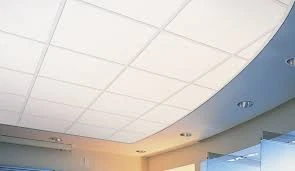- Afrikaans
- Albanian
- Amharic
- Arabic
- Armenian
- Azerbaijani
- Basque
- Belarusian
- Bengali
- Bosnian
- Bulgarian
- Catalan
- Cebuano
- Corsican
- Croatian
- Czech
- Danish
- Dutch
- English
- Esperanto
- Estonian
- French
- German
- Greek
- Hindi
- Indonesian
- irish
- Italian
- Japanese
- Korean
- Lao
- Malay
- Myanmar
- Norwegian
- Norwegian
- Polish
- Portuguese
- Romanian
- Russian
- Serbian
- Spanish
- Swedish
- Thai
- Turkish
- Ukrainian
- Uzbek
- Vietnamese
Νοέ . 28, 2024 05:44 Back to list
Exploring the Benefits of Gypsum and Grid Ceiling Systems in Modern Interiors
Exploring Gypsum and Grid Ceilings A Comprehensive Guide
Ceiling design plays a crucial role in interior aesthetics and functionality. Among the various options available, gypsum ceilings and grid ceilings have emerged as popular choices for both residential and commercial spaces. This article delves into the characteristics, advantages, and applications of gypsum and grid ceilings, assessing why they are favored in modern construction and design.
Understanding Gypsum Ceilings
Gypsum ceilings, often referred to as gypsum board or drywall ceilings, are constructed using gypsum boards that are attached to a framework of metal or wooden studs. This material is known for its fire-resistance, sound insulation properties, and ease of installation. Gypsum ceilings can be designed in various forms, including flat, curved, or textured surfaces, allowing for creative architectural designs.
Advantages of Gypsum Ceilings
1. Fire Resistance One of the primary advantages of gypsum boards is their inherent fire-resistant properties. They are composed of chemically combined water, which is released as steam when exposed to fire, delaying the spread of flames.
2. Sound Insulation Gypsum has excellent soundproofing qualities, making it an ideal choice for spaces where noise reduction is essential, such as offices, theaters, and residential homes.
3. Aesthetics and Versatility Gypsum ceilings can be easily manipulated into various shapes and forms. They can be painted or finished with textures, giving interior designers a wide palette to work with.
5. Eco-Friendliness Many gypsum products are made from recycled materials, making them a sustainable choice for environmentally conscious builders and homeowners.
Understanding Grid Ceilings
gypsum and grid ceiling

Grid ceilings, also known as drop ceilings or suspended ceilings, consist of a metal framework that supports lightweight panels, usually made from mineral fiber, fiberglass, or metal. This type of ceiling is mounted below the actual ceiling, creating a space where ductwork, electrical wiring, and plumbing can be concealed.
Advantages of Grid Ceilings
1. Accessibility One of the significant benefits of grid ceilings is the easy access to the space above. This is particularly beneficial for maintenance and repair work, as panels can be removed or replaced quickly without disrupting the entire ceiling.
2. Installation Flexibility Grid ceilings can be installed in a variety of environments, including basements, offices, and retail spaces. The modular nature allows for rapid installation and flexibility in design.
3. Cost-Effectiveness Generally, grid ceilings are more economical to install than traditional ceiling types. The materials are inexpensive, and the labor costs tend to be lower due to the straightforward installation process.
4. Acoustic Control Many grid ceiling tiles are designed to absorb sound, making them ideal for commercial spaces where noise control is critical, such as in restaurants and educational institutions.
5. Design Variety Grid ceilings come in a multitude of designs and finishes, allowing builders and designers to create distinctive looks while maintaining functionality.
Choosing the Right Option
When deciding between gypsum and grid ceilings, several factors need to be considered, including the specific needs of the space, budget, and desired aesthetic. For instance, gypsum ceilings may be more suitable for high-end residential interiors or spaces requiring significant sound insulation. Conversely, grid ceilings may be better for commercial environments where access to the above ceiling is necessary.
In conclusion, both gypsum and grid ceilings offer distinct benefits suited to various applications. While gypsum ceilings excel in aesthetics and thermal insulation, grid ceilings provide practicality and ease of access. Ultimately, the choice depends on the requirements of the project, highlighting the importance of understanding each ceiling type’s unique characteristics in making an informed decision. As architecture and design continue to evolve, both ceiling types will undoubtedly maintain their significance in creating functional and aesthetically pleasing environments.
-
Transform Interiors with PVC Gypsum Ceiling: A Stylish, Durable, and Moisture-Resistant SolutionNewsMay.19,2025
-
The Smart Interior Upgrade: Discover the Durability and Versatility of Gypsum Ceiling Access Panel SolutionsNewsMay.19,2025
-
The Smart Choice for Interior Design: Discover the Value of PVC Gypsum Ceiling SolutionsNewsMay.19,2025
-
Mineral Fiber Ceiling Tiles: The Smart Blend of Performance and AestheticsNewsMay.19,2025
-
Mineral Fiber Ceiling Tiles: The Superior Choice Over Gypsum for Sound and Fire SafetyNewsMay.19,2025
-
Mineral Fiber Ceiling Tiles: Eco-Friendly Strength and Style for Every CeilingNewsMay.19,2025







